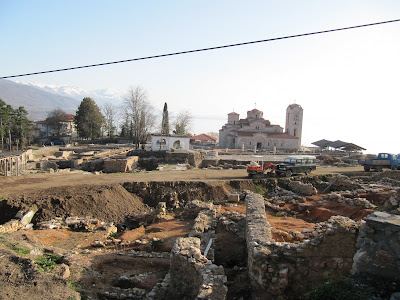Ohrid is notable for having 365 churches, one for each day of the year, which explains why our guide said some refer to it as Slavic Jerusalem. It, like southern Serbia, was under Ottoman rule from the 14th-20th century.
One of the more famous churches is that built for Saint Clement of Ohrid, the most prominent disciple of Saints Cyril and Methodius. Those names probably don't mean anything to you but the former is the eponym for Slavic languages' Cyrillic alphabet. Clement's teachers created the Glagolitic alphabet, the oldest known Slavic alphabet, and inspired Clement to script the Cyrillic alphabet for which he used a Greek foundation with certain sounds from the Glagolitic alphabet. Around the 12th Century (ten centuries after Clement's day) the Cyrillic alphabet began to dominate over the Glagolitic alphabet. Clement founded a school which popularized Christianity using this alphabet and he's celebrated as a patron saint of education and language.
Saint Clement Church

They are a building a university based on the one Saint Clement created in the same spot

We also explored Samuil's Fortress which was the capital of the First Bulgarian Empire in the middle ages. I really like all these European fortresses, they feel so fantastical to me like out of Robin Hood. But I mean in actuality they were built out of warmongering necessity so it's much more grim than its pretty, symmetrical exterior lets on.
View from the fortress

I keep forgetting culture in the States. Well not completely but I've become so accustomed to this array of starters and all other Serbian food that I forget how different it is than what I ate for the first 18 years of my life and I can't quite remember what's usual at American restaurants.

This goes for architecture as well. The red-roofed, single-story, brick houses are all you see in villages and towns around Serbia and even in the neighborhood I live in in Nis. And that's not typical for America, right? I guess one of the factors complicating my fuzzed memory is that people always say how typical America is an oxymoron since America is the 'melting pot.' In the past six months cultural differences have become norms for me so I sometimes forget that I'm living in Serbia and more often I forget about the culture shock waiting for me in the US.

Jill i ja



Team Serbia


It was the perfect time to go because spring had just arrived but the summer tourists had not




No comments:
Post a Comment